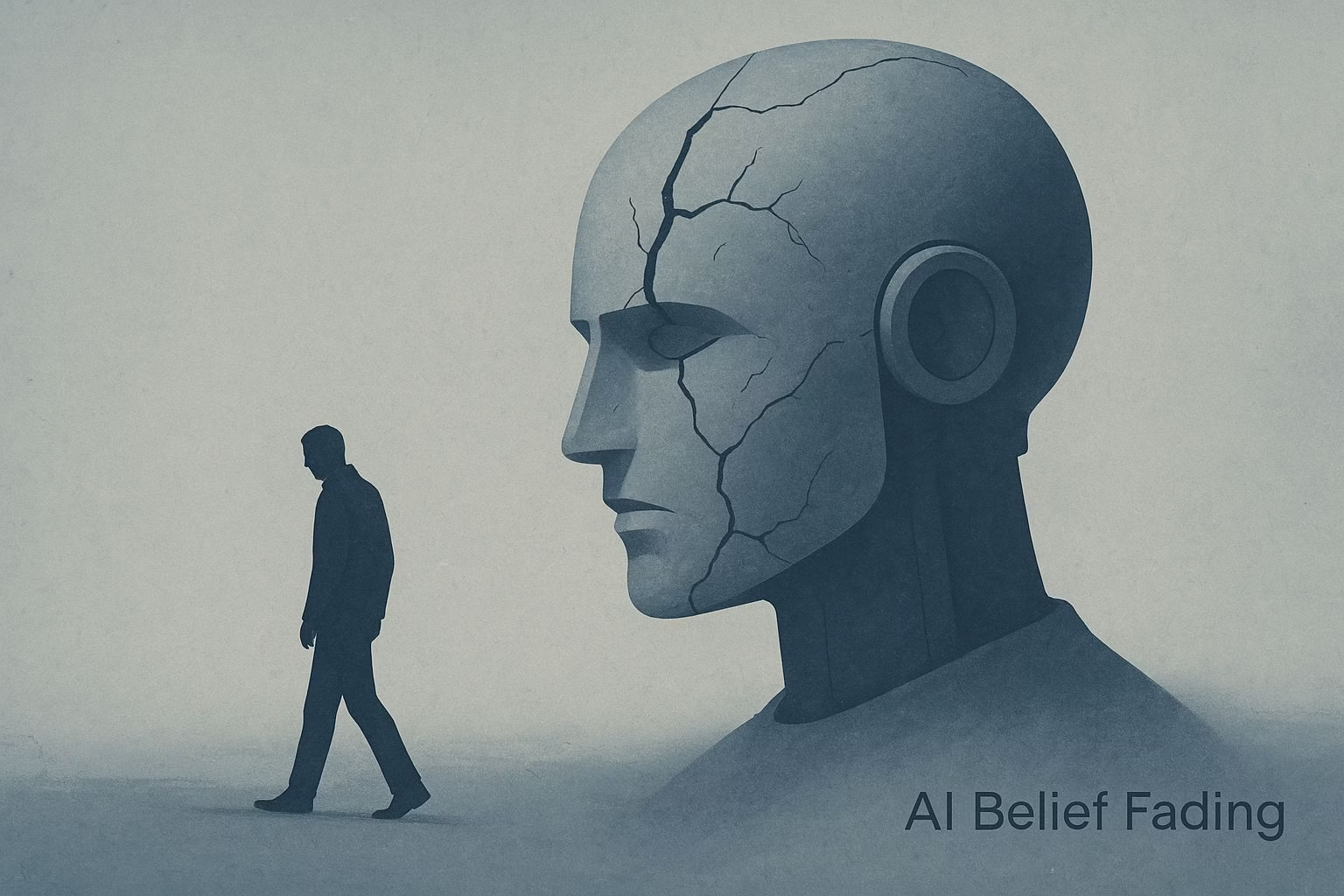AI True Believers Are Losing Faith
Summary
- AI tools are losing user trust due to inconsistency and regressions.
- Productivity gains are overstated while costs and oversight increase.
- Accountability remains absent, fueling a growing backlash.
- Reliable use cases still exist, but they depend on clear verification.
- The future of AI will favor stability over spectacle.
I used to think we were at the start of a revolution. People built entire systems around large language models, convinced they would reshape work, creativity, and business itself.
But the mood has shifted. The same users who once called AI the “future of everything” are now describing it as unreliable, unstable, and nearly impossible to trust for serious tasks.
Across developer boards, Reddit, and consulting circles, the same complaints echo: models that regress with each update, hallucinate under pressure, and break once-stable automations overnight.
What worked on GPT-4.1 barely holds up under GPT-5. The idea that this is the “worst it’ll ever be” has started to feel like a cruel joke.
The frustration runs deeper than just bugs. The systems are random, the safeguards inconsistent, and the corporate hype relentless.
For anyone who has tried to build around these tools, the experience feels less like building software and more like debugging chaos.
Even professionals who make their living in AI consulting now spend most of their time fixing broken client workflows.
Businesses that thought they could automate away humans are quietly hiring again, embarrassed by the mess.
The excitement that once surrounded AI has become skepticism.
What was promised as a reliable layer of intelligence now looks more like a shaky foundation of prediction.
Why People Are Losing Trust in AI Tools
What began as small inconsistencies in model outputs has turned into a deeper crisis of confidence. Developers can no longer rely on AI systems to behave the same way twice.
One update can wreck months of work, and users are left without a rollback option. The frustration isn’t about performance dips; it’s about the unpredictability.
Even in professional settings, large companies have realized that “AI-powered” doesn’t always mean “better.”
Corporate teams now spend more time monitoring model behavior than benefiting from automation. The reality is that accuracy, context retention, and reproducibility are still far from solved.
For industries like law, healthcare, and finance, that level of instability is unacceptable.
The other side of the problem is the obsession with scale. Instead of fixing what’s broken, many AI firms push out bigger models with more parameters, while guardrails and compliance layers pile on top.
The result is slower systems that argue, hallucinate, or shut down rather than admit confusion.
This constant tug-of-war between power and predictability has pushed many early believers toward disillusionment.
It’s no longer about whether AI can generate words or code. It’s about whether you can trust it to do so consistently.
And right now, that trust is fading fast.
The Illusion of Progress
The phrase “this is the worst it’ll ever be” became a kind of slogan among AI enthusiasts. But recent months have shown that the technology doesn’t always move forward in a straight line.
GPT-5, for example, has broken older automations that ran flawlessly under GPT-4.1. A developer can run the same prompt twice and get two entirely different results, each “confident” in its answer.
This problem isn’t new, but it’s now hitting production environments where people depend on reliability.
Imagine a medical app, legal drafting tool, or financial model giving subtly different advice from one week to the next. It’s not just annoying, it’s dangerous.
AI’s defenders often say that small regressions are the cost of progress. But for many users, progress that can’t be trusted isn’t progress at all.
The underlying issue is that these systems don’t understand what they’re doing. They predict patterns without awareness, and that lack of grounded reasoning shows in every inconsistency.
We’re seeing the limits of probabilistic “intelligence.”
Until AI models can reason through their own logic and provide transparent justifications, every update risks erasing trust rather than building it.
The Real Productivity Myth
The hype around AI productivity has become its own trap. Executives and influencers keep insisting that tools like ChatGPT, Copilot, and Gemini will transform the modern workplace.
But in practice, many of these “AI-powered” products add more friction than they remove. They help with summaries, quick drafts, or code snippets, but when accuracy matters, human review is still essential.
For companies, this has created a strange economic loop. Firms invest heavily in AI integration, only to hire consultants later to clean up the damage.
Projects that were supposed to cut costs now require constant oversight, version testing, and patching. The result? More complexity, not less.
Some AI experts still believe the current chaos is temporary, that these tools will soon mature into reliable digital workers.
But that optimism ignores the underlying issue: they’re built on non-deterministic systems. You can’t run a business on something that’s unpredictable by design.
Even AI’s biggest advocates now admit that genuine productivity gains are rare. The technology can assist, but not replace.
For most users, the dream of “fully automated workflows” has quietly shifted into a more modest reality: AI as a slightly better search engine, summarizer, or writing assistant.
The Accountability Vacuum
What makes this moment especially dangerous is the lack of accountability. In the U.S., there are virtually no regulations forcing companies to audit or explain AI-driven decisions.
That means these opaque systems are already shaping credit scores, healthcare eligibility, job applications, and even legal judgments without anyone knowing how those outcomes were decided.
When an AI model misfires, who’s responsible? The developer? The company using it? Or the AI itself? So far, the answer has been no one.
The absence of oversight has created a perfect shield for corporations. They can blame the “algorithm” for biased or harmful results while hiding behind technical jargon and disclaimers.
Even the supposed safety layers, the “guardrails” meant to prevent harm, are unreliable. They can block harmless prompts while letting dangerous outputs slip through.
The problem isn’t a lack of intent; it’s a lack of control. Developers are building systems that even they can’t fully explain or debug.
The result is a growing sense that the AI industry is moving faster than it can handle.
Without transparency or consistent audit standards, the technology is not only untrustworthy but also unaccountable.
What Still Works with AI
Despite the collapse in confidence, not everything about AI is broken. Some areas, such as summarization, transcription, and image recognition, have proven remarkably stable.
These use cases work because they’re measurable and easy to verify. You can compare an AI summary to the source text, check a transcript against audio, or judge an image match by sight.
In these contexts, correctness isn’t subjective.
That’s where large language models still shine: when the task has a clear right answer and enough reference data to guide them.
It’s why people still rely on ChatGPT for quick explanations, rewrites, or brainstorming. It’s also why models like Gemini and Claude are quietly improving in specific verticals like customer support or data parsing.
But outside these predictable zones, performance drops fast. Creative writing, code generation, and research remain fragile.
They depend too much on human-level reasoning that AI doesn’t possess. The smart approach now is to treat AI as an assistant, not a replacement, a tool that complements your judgment rather than imitates it.
AI can still help you work faster. It just can’t guarantee that the work will be right.
Where This Could Be Headed
If the AI boom slows down, it won’t be because people stopped caring. It will be because people finally learned how fragile the technology is.
The same engineers and early adopters who built their businesses around GPT are now warning others to step carefully.
The bubble won’t burst overnight, but cracks are showing. Investors are nervous, companies are pulling back from overhyped projects, and users are demanding transparency.
When the dust settles, the survivors won’t be the loudest or biggest models. They’ll be the ones who focus on explainability, consistency, and trust.
The good news is that all this skepticism may be healthy. A reality check was overdue.
The industry is maturing, slowly, into something more grounded. Instead of chasing “intelligence,” the next phase will likely be about reliability and accountability.
RoboRhythms.com has been tracking this shift for months. The conversation is no longer about AI replacing people. It’s about building tools that people can actually depend on.

